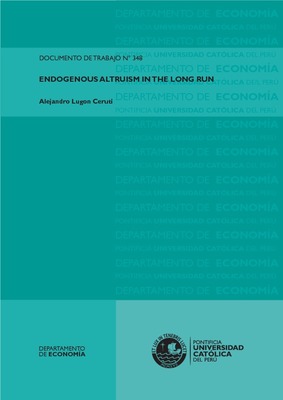| dc.contributor.author | Lugon Ceruti, Alejandro | |
| dc.date.accessioned | 2015-03-19T20:37:54Z | |
| dc.date.available | 2015-03-19T20:37:54Z | |
| dc.date.issued | 2012 | |
| dc.identifier.uri | http://repositorio.pucp.edu.pe/index/handle/123456789/46989 | |
| dc.description.abstract | El objetivo de este trabajo es construir un modelo de altruismo endógeno. El altruismo es una actitud que influencia nuestras acciones hacia los otros. El modelo presentado asume que esta influencia también opera en la dirección opuesta: es decir, los agentes modifican su nivel de altruismo basados en las acciones de los otros agentes. Este trabajo se basa en un modelo con dos agentes cuyos ingresos son aleatorios. De acuerdo a la realización de los ingresos se realizan trasferencias entre los agentes. Estas transferencias transmiten información sobre el nivel de altruismo de los donantes. Los receptores usan esta información para ajustar su propio nivel de altruismo. Si la transferencia recibida implica que el nivel de altruismo del otro es mayor (menor) que el nivel del receptor, este último aumentará (disminuirá) su nivel de altruismo. Este comportamiento induce un proceso estocástico para los niveles de altruismo. Lo valores de largo plazo son estudiados por medio de herramientas analíticas y simulaciones numéricas. | es_ES |
| dc.description.abstract | The aim of this paper is to provide a model where altruism is determined endogenously. Altruism is an attitude that influences our actions toward other people. The model presented in this paper assumes that this influence also operates in the opposite direction: that is, people modify their altruism based on the actions of other agents. The paper uses a dynamic setup with two agents whose incomes are random. Depending on the incomes realized, transfers are made. These transfers convey information about the level of altruism of the donors. The agents use this information to adjust their own level of altruism. If the transfer received by an agent implies that the altruism level of the other agent is higher (lower) than that of the receiver, then the latter will increase (decrease) his level of altruism. This behavior induces a stochastic process for the levels of altruism. The long level of altruism is studied using both analytic and computer simulations tools. | en_US |
| dc.language.iso | spa | es_ES |
| dc.publisher | Pontificia Universidad Católica del Perú. Departamento de Economía | es_ES |
| dc.relation.ispartof | urn:issn:2079-8466 | |
| dc.relation.ispartof | urn:issn:2079-8474 | |
| dc.relation.ispartofseries | Documento de Trabajo;348 | es_ES |
| dc.rights | info:eu-repo/semantics/openAccess | es_ES |
| dc.rights.uri | http://creativecommons.org/licenses/by-nc-nd/2.5/pe/ | * |
| dc.subject | Donaciones | es_ES |
| dc.subject | Disparidad de ingresos | es_ES |
| dc.subject | Modelos matemáticos | es_ES |
| dc.title | Endogenous altruism in the long run | es_ES |
| dc.title.alternative | Altruismo endógeno en el largo plazo. | es_ES |
| dc.type | info:eu-repo/semantics/workingPaper | |
| dc.type.other | Documento de trabajo | |
| dc.subject.ocde | http://purl.org/pe-repo/ocde/ford#5.02.00 | |
| dc.publisher.country | PE | |
| renati.advisor.orcid | https://orcid.org/0000-0001-7956-5634 | |


